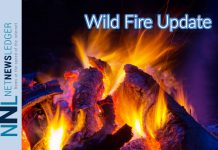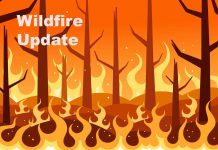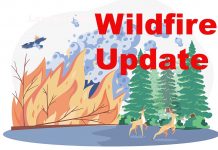THUNDER BAY – The wildfire situation across the region continues to focus on the two fires out of control in the far north. Evacuations from Pikangikum have stopped. 2LT Christopher Dube with the RCAF tells NetNewsLedger, “Since receiving a request for assistance from the Province of Ontario for the evacuation of Pikangikum First Nation, the Canadian Armed Forces has evacuated over 1,700 residents to multiple host communities in both Ontario and Manitoba with the dedicated help of over 30 Canadian Rangers from 3 Canadian Ranger Patrol Group.
“In the past 48 hours, the need for military airlift capabilities has waned. In close collaboration with Pikangikum First Nation, the Province of Ontario, and all relevant partners, the Canadian Armed Forces airlift support will be drawn down today as it has been deemed that the Province of Ontario, through the Ministry of Natural Resources and Forestry’s contractual arrangements for commercial airlift, is more than capable to satisfy the need at this time.
“Should the need for support arise or if conditions change, military air support that is currently on standby can be re-activated.”
Forest Fire Situation Update – Northwest Region June 5, 2019
There were no new fires in the Northwest Region by the late afternoon of June 5.
At the time of this update there were two active fires in the Northwest, one of which was not yet under control.
Red Lake 14 near Pikangikum
Red Lake 14, near the community of Pikangikum, is 3,835 hectares in size and listed as not yet under control. Aided by a few days of lower intensity fire behavior, a total of 14 FireRanger crews and five contract Type 2 (sustained action) crews continue to establish new fire breaks and close the gaps in existing hose lines to prevent any further spread of the fire. Rain is expected to arrive in the Pikangikum area towards the weekend.
Fire hazard in the Northwest Region
The fire hazard in the Northwest Region ranges from areas of high hazard in portions of the Red Lake and Sioux Lookout sectors, to low and moderate hazard across the southern sectors of Kenora, Dryden, Fort Frances, Thunder Bay and Nipigon.
AFFES staff deployed out of province
Approximately 230 staff members from Aviation, Forest Fire and Emergency Services are assisting the province of Alberta with its escalated fire situation. This includes FireRangers, support staff and one incident management team. In addition, the Ministry of Natural Resources and Forestry is providing equipment such as pumps, hose and hand tools to support Alberta.
More than 50 staff members from Aviation, Forest Fire and Emergency Services have been deployed to assist the Yukon with current active forest fires. This includes FireRangers and support staff.
There are also an additional 2 support staff members from Ontario who have been deployed out of province, one to assist the Canadian Interagency Forest Fire Centre in Winnipeg, and one to the Northwest Territories.
The sharing of resources across Canada is facilitated by the Canadian Interagency Forest Fire Centre in Winnipeg under the Mutual Aid Resource Sharing agreement.
The fire situation in Ontario has been relatively quiet since the beginning of the 2019 fire season, and we remain fully prepared to respond to any forest fires that may arise here at home.
Help prevent forest fires
Adopt safe campfire practices! Choose the site of your campfire carefully and keep your fire small. Stay nearby: never leave it unattended. Put your fire out by drowning it with water. Be sure that it is extinguished prior to leaving the site. Stir the ashes with a stick to uncover hot coals and then drown it again. You can never be too safe.
Consider alternatives to burning brush or yard waste, such as chipping or composting when possible, or saving burn piles for the fall or after the fire season. Use of outdoor fires must follow the outdoor burning rules set out in the Forest Fire Prevention Act of Ontario. Fires are to be started no sooner than two hours before sunset and extinguished no later than two hours after sunrise. Fires should never be left unattended and tools and water should be close at hand to put the fire out. More details on outdoor burning regulations can be found online at Ontario.ca/forestfire
To see a complete list of fires across the province click on our interactive map. You can also get the latest update on the condition of any fire by clicking the fire icon.
Fire numbers and online information:
- Forest Fire Reporting Number – 310-FIRE (3473)
- Twitter account






